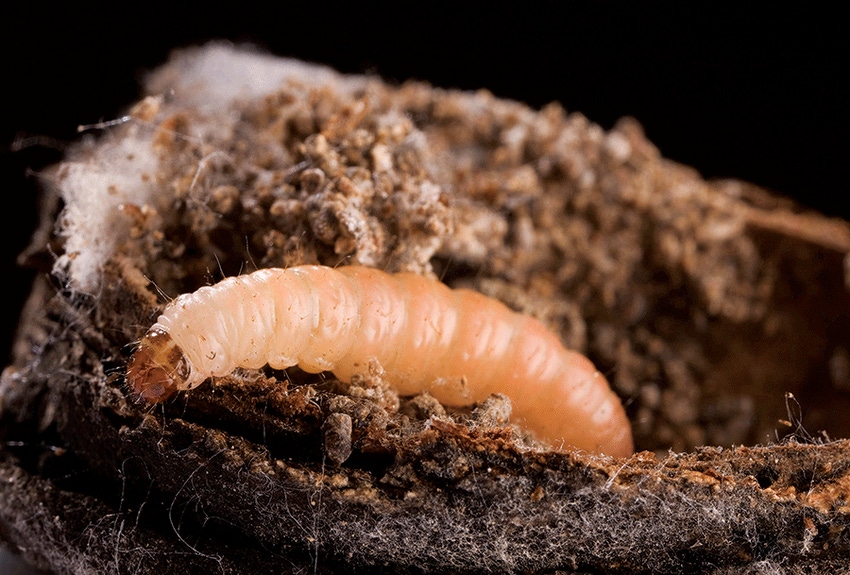
The fight against the damaging Navel orangeworm (NOW) in California nut orchards is far from new, and producers are acutely aware of the risks associated with the pest and the economic losses it causes.
In 2017, the economic cost to many nut growers was substantial, but continuing research has refined strategies that are beginning to help the industry gradually gain ground in the fight against the invasive pest.
So far this year, early estimates reveal that nut damage and subsequent losses from NOW larvae, will be less than in 2017, though the pest remains a major concern in almond, pistachio, and even walnut orchards. University of California Agriculture and Natural Resource (UC-ANR) advisors note that a successful management plan for controlling Navel orangeworm starts in the fall following harvest and continues through the winter months.
"Sanitation is the foundation of Navel orangeworm control," says Pheobe Gordon of UC Cooperative Extension. "Post-harvest sanitation is the first step in slowing the emergence of the pest when the new season begins."
Sanitizing an entire orchard involves removing nuts that were infected by larvae at the time of hullsplit. Many of these infected nuts tend to stick to the tree and can be difficult to dislodge, similar to mummy nuts, which often indicate hull rot than can be caused by high levels of boron or other elements. The mummy nuts are also subject to infection by Navel orangeworm, making them a safe hiding place for larvae.
But whether it is larvae-infected nuts on the ground or mummy nuts that cling to the tree, sanitation of an orchard reduces pest pressure by killing overwintering larvae and by removing their first food source.
REMOVE MUMMIES EARLY
"Following harvest it becomes necessary to remove clinging nuts, either by shaking the tree or by crews using poles to dislodge any mummy nuts that remain. Many growers opt to wait for foggy mornings or fall rains when the moisture levels help to break down the nut, making it easier to dislodge," Gordon says. However, using heavy equipment on wet grounds can cause damage in an orchard, and for that reason many growers opt to remove the clinging nuts as early as is reasonably possible.
UC-ANR Extension IPM Specialist Dr. Jhalendra Rijal is one of the leading researchers on Navel orangeworm control in almonds and walnuts. "We have been working vigorously to better understand Navel orangeworms, how they reproduce, migrate, and survive,” he says.
“They are a major pest for tree nuts, especially almonds and pistachios, and have been known to migrate from pistachio to almond trees with ease. Mummy sanitation is the foundation of Navel orangeworm control. Mummy nuts not only serve as a house for larvae during the winter, but also provide the only source for egg deposition for the first generation in the spring. When mummy nuts collect on the ground, they should be flailed by mowing them so larvae do not survive.”
Failure to sanitize properly can create serious problems for an orchard when spring arrives, and that can prompt the need for additional control methods, such as application of more pesticides than expected, which increases input costs to growers. "We will often see four generations of orangeworm in the San Joaquin Valley,” Rijal says.
After bloom, eggs or worms in early split, damaged, or dropped nuts in the coming weeks and months indicate NOW presence and a tell-tale sign of things to come. As far as scouting is concerned, NOW have a pair of brown, crescent-shaped marks behind the head, which are absent in codling moth larvae. Spray control for NOW should not be initiated until hullsplit. To do otherwise can increase the chances of developing resistance issues.
But the greatest single tool to prevent NOW infestation is aggressive sanitation. According to UC-ANR guidelines, all mummy nuts should be removed from trees no later than Feb. 1, and ground mummies should be destroyed before Mar. 15.
"It's proven technology,” Rijal says. “Control of Navel orangeworm starts in the fall and winter with good sanitation practices. In southern areas of the Valley, where NOW problems are more intense than in the northern parts of the San Joaquin Valley, starting the sanitation process as early as possible is a good idea. And keep in mind that scouting back through the orchard later in the winter is good, as well, to catch any mummy nuts in the trees and on the ground for final cleanup. It's very important to clean the orchard the best that is possible."
Thresholds for NOW after sanitation vary depending on how far north or south an orchard is located, Rijal notes. In northern reaches of the San Joaquin Valley and Sacramento Valley, where more moisture is available and rainfalls are greater, thresholds are slightly higher compared to the south San Joaquin Valley. According to UC guidelines, that threshold is no more than two mummy nuts per tree. For southern orchards, one nut for every five trees and/or eight ground mummy nuts per tree after sanitation exceeds threshold.
Currently, many growers have completed their first round of sanitation and are scouting through their orchards in search of remaining nuts on trees and on the ground. Some growers are waiting for cooler temps and higher moisture rates to facilitate the removal of clinging nuts remaining on their trees.
About the Author(s)
You May Also Like






